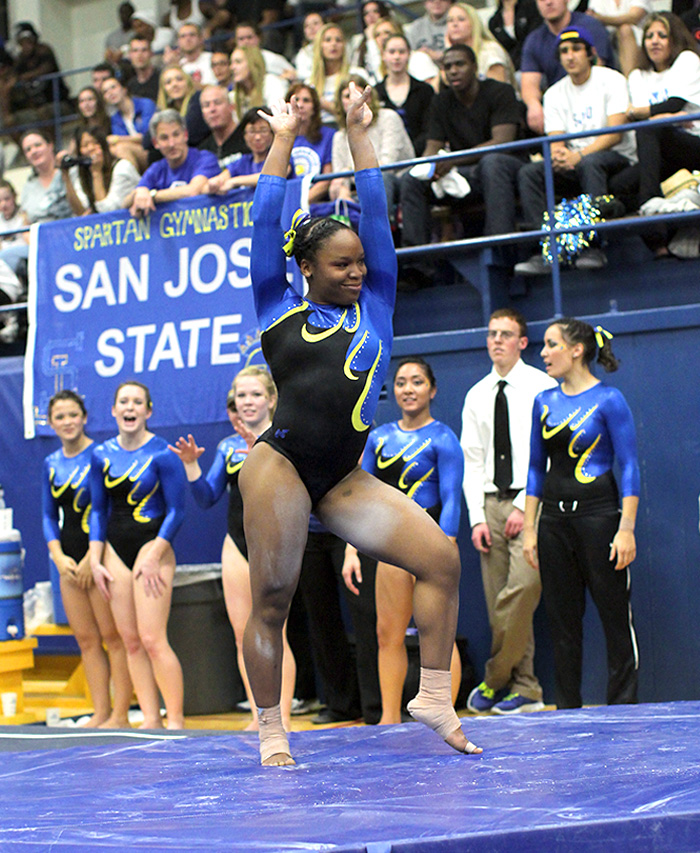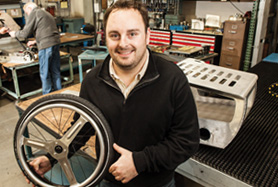Spartan Women in Sport: Thomasina Wallace, ’12 Kinesiology

Photo: San Jose State Athletics // Terrell Lloyd

Photo: San Jose State Athletics // Terrell Lloyd
Thomasina Wallace stands at the corner of the springy mat, dressed in a sparkly black leotard and her hair tied up in a blue ribbon. Her San Jose State teammates hover just outside the boundary of the mat, cheering her on as she prepares for the floor routine. When the music starts she snaps into action, flipping and twirling across the mat with a practiced precision. The gym is full of noise and activity, and yet the expression on her face is confident, serene; she does not appear distracted. With each leap she launches herself higher, tucking her legs underneath her and spreading her arms wide, somehow both playful and powerful, as if two minutes of tumbling were just a part of her everyday routine.
In many ways it was back then in January 2012. Wallace, ’12 Kinesiology, had been competing in the Junior Olympic gymnastics program since she was five years old. As a high school club gymnast, she placed second at the Junior Olympic Nationals and was subsequently invited to a Junior Olympic Nationals camp. Her senior year, she was recruited to San Jose State by Head Coach Wayne Wright, who saw beyond her leg injury to the focused athlete inside. He was right to trust in her abilities. As a freshman, Wallace became the first Spartan to win a regional title, the first Spartan gymnast to be named Western Athletic Conference champion, and one of the first four Spartan gymnasts to compete in the NCAA Championships. Her stamina and confidence were especially evident in her senior year at SJSU, when she broke the university record for best all-around score, improving on it twice more before graduating.
Though these individual accomplishments were important, requiring an enormous investment of time and energy, for Wallace the experience of competing on a college team represented a much bigger journey. As a young gymnast growing up in Southern California, she had to train in clubs because the sport was deemed too big a liability to offer in school. Club gymnastics placed a greater emphasis on the development of athletes as individuals, with gymnasts focusing on their own growth on the vault, uneven bars, balance beam and floor exercise. It didn’t take long for Wallace to recognize that she was one of few girls of color competing at meets.
“With our sport, it comes to a point where somebody else judges you,” Wallace says. “If they don’t like what they see, what team you are with, who you are as a person, or even your ethnicity, that can be a challenge.”
Wallace is quick to point out that over the 20 years since she started competing, the landscape of gymnastics has begun to shift. She says that she was often so focused on the task at hand—mastering the landing at the end of a difficult routine, maintaining momentum or pulling off a series of complicated flips—that she didn’t notice when outside factors, such as the name of her club or the color of her leotard or her race, appeared to play a role in the way she was judged. One time in particular, however, her parents noticed a judge’s personal bias affect the way Wallace was scored.
“The fact is that you can’t really do anything about it, especially back then,” she says. “It was not as popular for different ethnicities to be in the sport when I was growing up, so it was overlooked. It sucks when politics get involved, or someone’s own personal feelings can possibly dictate if a gymnast makes a national meet or if they do not because of something they represent. I feel they should judge just based on how the gymnast competes in her routine and not what she looks like, or what team she is a part of.”

Photo: San Jose State Athletics // Terrell Lloyd
When Wallace arrived at San Jose State, she was inspired by collegiate gymnastics’ focus on teamwork. Though gymnasts continued to compete individually, their performances bolstered each other and raised the reputation of the entire team.
“You are competing for each other, your teammates, in order to have the end of goal of making it to regionals and hopefully qualifying for nationals,” she says. “Collegiate gymnastics is not about you, but about how you can help the team. How well can I compete to help my team at this competition? And that’s how I went into every routine.”
Motivated by a desire to continually push the sport forward, Wallace graduated from San Jose State with plans to continue competing. It soon became clear, however, that after two decades of competition, her body needed a break. She will be starting a master’s program in sport and performance psychology at California Baptist University in fall 2018 and has high hopes for the next generation of gymnasts.
“I see more and more people of different ethnicities trying the sport and competing successfully,” she says. “I think that it’s definitely taken a turn where it doesn’t matter what color you are. If you compete well, the judges will judge you accordingly. And I tell the girls I coach, gymnastics is a mental game with yourself. Twenty percent is talent and 80 percent is how mentally prepared you are to perform your routines while others are judging you. Learning how to manage the mental aspect of the sport can help any gymnast become the best they can become.”



